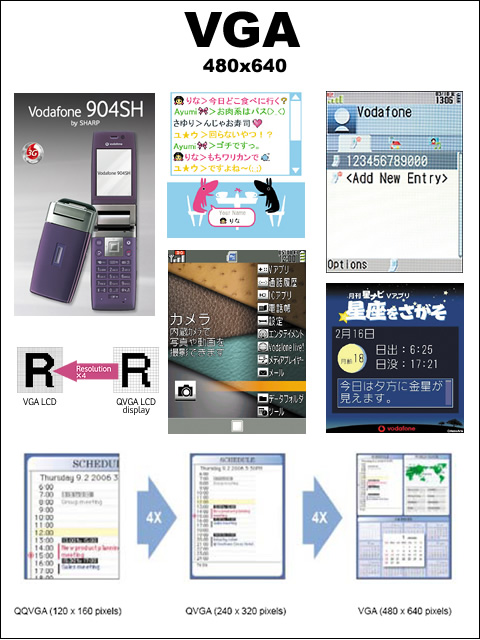Mobile VGA

Heh. No sooner than I write about how QVGA is going to make a huge change in the marketplace, I read this morning that Vodafone Japan (soon to be Softbank/Yahoo!) has just launched the Sharp VGA phone - the 904SH - we read about during 3GSM. This is pretty interesting, as for some reason I had it in my mind that launch would be a bit farther out. The fact that it's available now changes some things in my mind. I mean, hey - just because a cool new phone in Japan was launched (with other bene's like GPS and a 3.2 megapixel camera) hardly means that it'll show up in your local phone store in Kansas tomorrow, but it *does* mean that the clock has started ticking, and the lag between the advanced Asian mobile markets (Japan, Korea) and the West is arguably getting shorter.
I think that I'm still confident in predicting that QVGA will be the sweet spot for mobile displays in the mid-range for the next few years, but a phone with a VGA-resolution screen does bring up the same questions in my mind about resolution vs. physical screen size. There's definitely an optimal physical size out there, I'm just not sure what it is. It's not the size of a PDA - it's just too big to lug around. It *may* be the size of O2's XDA II mini pda phone - which is basically a fat mobile, with most of the face covered by the screen. It's bigger than most of today's mobile displays, that's for sure...
Side note - this of course is the advantage of Flip phones and why I've finally come around to realizing they are more practical than candy bars. Not only do flips protect the keys from accidental dialing, protect the screen from scrapes (being in the same pocket or bag as your keys generally) and curve around your face in a more natural way so you don't have to cup your hand to be heard, but flip phones also allow the screens and keypads to be much bigger, taking up the entire section they're on. Though I got into mobiles in Europe where the candy bar still rules, and was pretty biased that way for a while (quicker access to screen, no need to deal with flipping the phone open, etc.) the benefits of the flip form factor are pretty obvious now I think.
But here's the big question in my mind: How much of mobile phone user interfaces have been affected by screen resolution, and how much have they been the result of their physical size and the fact that they're usually operated with one hand (or just your thumb generally). VGA displays on a phone doesn't change some fundamental constraints of the device: You can't just slap a Windows 95-style UI onto a 2 inch screen and hand it off to a consumer - they'd go crazy or blind (probably both). Then again, current mobile UIs are completely inefficient for displays with so many pixels to play with.
My best guess about a solution to this problem in the future is "Zooming UIs." We're already seeing this in the new Nokia S60 Browser (the one based on KHTML/WebKit). It can browse normal pages by allowing the user to zoom in and out of the page, and enables them to go back and forth by seeing thumbnail screenshots of previous pages as well. I think this UI paradigm will need to be applied to the entire interface. This is pretty interesting if you think about it, because it means that designers will really have to adopt a way of thinking that is way beyond just minimum resolutions and layouts that "flow" - they'll have to embrace a UI that has constantly changing sizes. If you put that "log in" button in the corner of your screen with 8pt type, and the users happens to be zoomed all the way out for whatever reason - they'll never see it, for example.
Of course, "constantly changing" and "permanently flexible" does not exactly equate to "consumer friendly" does it? This is exactly what I'm trying to convey - there's going to be some interesting opportunities in the future in this area. The simplest thing for device makers to do will be to slap the same UI on the screen with better resolution - but it'll be the companies that really grok the opportunities that higher resolution provides that will get a competitive advantage.
-Russ